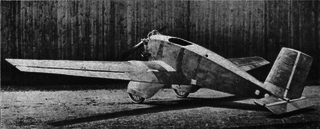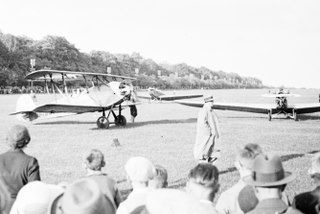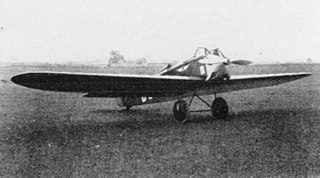
The Focke-Wulf Fw 44 Stieglitz ("Goldfinch") is a 1930s German two-seat biplane. An early design by Kurt Tank, it was produced by the Focke-Wulf company as a pilot training and sports flying aircraft. It was also eventually built under license in several other countries.

The Messerschmitt Bf 108 Taifun was a German single-engine sport and touring aircraft, developed by Bayerische Flugzeugwerke in the 1930s. The Bf 108 was of all-metal construction.

The RWD 9 was a Polish sports plane of 1934, constructed by the RWD team.

The Heinkel He 72 Kadett ("Cadet") was a German single-engine biplane trainer of the 1930s.

The Bücker Bü 133 Jungmeister was an advanced trainer of the Luftwaffe in the 1930s. It was a single-engine, single-seat biplane of wood and tubular steel construction and covered in fabric.

The Albatros L 59 was a single-seat German utility aircraft of the 1920s. It was a single-engine low-wing cantilever monoplane with large, spatted wide track undercarriage attached, unusually for the time not to the fuselage but to the wing roots. The whole aircraft was covered in 3-ply.
The Arado W 2 was a two-seat twin-engine seaplane trainer developed for the DVS in 1928. It was a cantilever monoplane with a fabric-covered steel tube fuselage that accommodated the pilot and instructor in tandem open cockpits. The undercarriage consisted of two pontoons carried on steel struts.

The Dornier Libelle, also designated Do A, was a German open-cockpit, all-metal, parasol wing, monoplane flying boat aircraft, with partly fabric-covered wings. A landplane version, built without sponsons and fitted with a fixed tailwheel undercarriage was produced as the Dornier Spatz.

The Focke-Wulf S 24 Kiebitz was a sport aircraft built in Germany in the later 1920s. It was a single-bay biplane of conventional design with equal-span, unstaggered wings, braced with N-type interplane struts. The pilot and a single passenger sat in tandem open cockpits, and it was fitted with a fixed tailskid undercarriage. The wings could be folded for transportation or storage, and the aircraft was designed to be towed by a car.

The Bayerische Flugzeugwerke M 18, was an airliner, produced in Germany in the late 1920s.

The BFW M.23, sometimes known as the Messerschmitt M 23, was a 1920s two-seat sporting aircraft designed by Willy Messerschmitt, and produced by Bayerische Flugzeugwerke (BFW). Examples won several prestigious races in 1929 and 1930.

The BFW M.27, sometimes known as the Messerschmitt M.27, was a German two-seat sports plane with a low, cantilever wing, open cockpits and a fixed undercarriage sold in small numbers at the start of the 1930s.

The BFW M.31, sometimes known as the Messerschmitt M.27, was a radial-engined German two-seat sports plane from 1932, with a low, cantilever wing, open cockpits and fixed undercarriage. Only one was built.
The BFW M.29 was a single-engine two-seat low-wing aircraft, designed by Willy Messerschmitt for the 1932 Circuit of Europe races.

The Henschel Hs 122 was a German army cooperation/reconnaissance aircraft of the mid-1930s, radial-engined and with a parasol wing. Though only pre-production variants entered service, the Hs 122 led on to the Hs 126 which was produced in large numbers.

The BFW M.21 was a single-engined biplane trainer designed by Willy Messerschmitt for the German Ministry of Transport. It was one of only two biplanes Messerschmitt designed, neither reaching production.
The BFW M.22 was a twin-engined medium bomber, designed by Willy Messerschmitt for the German Ministry of Transport. It was one of only two biplanes Messerschmitt designed, both unsuccessful.
The BFW M.26 was a single-engined cantilever-winged monoplane light airliner built in Germany in 1930. There were no sales and only one was built.

The Junkers T 19, originally known as the J 19, was a single-engined parasol winged all-metal 2/3-seat aircraft built in Germany in the early 1920s for training and touring. Its construction was too expensive for commercial success and only three were built, one later finding use as an engine test-bed.

The Udet U 1 was the first of a line of small, low-powered, low wing, cantilever monoplanes built in Germany in the early 1920s.
















